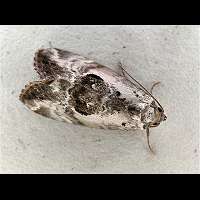Rosy Marbled Elaphria venustula
Many moth loving humans have been fooled by the Rosy Marbled. It is extremely small and has the markings of a Tortrix Moth. Many open their books in the Tortrix section and are unable to find the Rosy Marbled. Usually you need an expert pointing out to you this is a very small Owlet. Once you know that, the rest is easy: the Rosy Marbled is unmistakable. When resting the wings are held upwards a bit. The basic colour is pinkish white. The pink is hardly visible in pictures. In worn out animals it is also gone partly or entirely. The wingspan is just some 19 to 23mm.
In June the eggs are deposited one by one on the underside of leaves of the foodplant. The caterpillars appear soon after and feed in July and August. By the end of August the caterpillars disappear underground where pupation takes place. The pupa overwinters. In May or June next year the first fresh moths appear. The caterpillar of the Rosy Marbled is dark reddish brown, even though freshly moulded animals are lighter at first. There is a thin, often faint orange dorsal line. The front tapers towards the head. This is caused by the segments 2 to 5 which are swollen. The head is greyish green with black markings. The caterpillars grow to a length of 14 to 17mm. The main foodplant probably is Tormentil, but the larvae are found on bramble, broom and cinquefoil as well.
The Rosy Marbled flies about from early dusk. It may be seen during the day, when disturbed resting. Females may be caught by netting them in dusk, for they are not attracted to light. Males come to light readily. This species is on the wing for a short period of time only. The first appear by mid-May and the last are seen by the end of June. A widespread but often local species in South and Southeast England only.
Many moth loving humans have been fooled by the Rosy Marbled. It is extremely small and has the markings of a Tortrix Moth. Many open their books in the Tortrix section and are unable to find the Rosy Marbled. Usually you need an expert pointing out to you this is a very small Owlet. Once you know that, the rest is easy: the Rosy Marbled is unmistakable. When resting the wings are held upwards a bit. The basic colour is pinkish white. The pink is hardly visible in pictures. In worn out animals it is also gone partly or entirely. The wingspan is just some 19 to 23mm.
In June the eggs are deposited one by one on the underside of leaves of the foodplant. The caterpillars appear soon after and feed in July and August. By the end of August the caterpillars disappear underground where pupation takes place. The pupa overwinters. In May or June next year the first fresh moths appear. The caterpillar of the Rosy Marbled is dark reddish brown, even though freshly moulded animals are lighter at first. There is a thin, often faint orange dorsal line. The front tapers towards the head. This is caused by the segments 2 to 5 which are swollen. The head is greyish green with black markings. The caterpillars grow to a length of 14 to 17mm. The main foodplant probably is Tormentil, but the larvae are found on bramble, broom and cinquefoil as well.
The Rosy Marbled flies about from early dusk. It may be seen during the day, when disturbed resting. Females may be caught by netting them in dusk, for they are not attracted to light. Males come to light readily. This species is on the wing for a short period of time only. The first appear by mid-May and the last are seen by the end of June. A widespread but often local species in South and Southeast England only.





